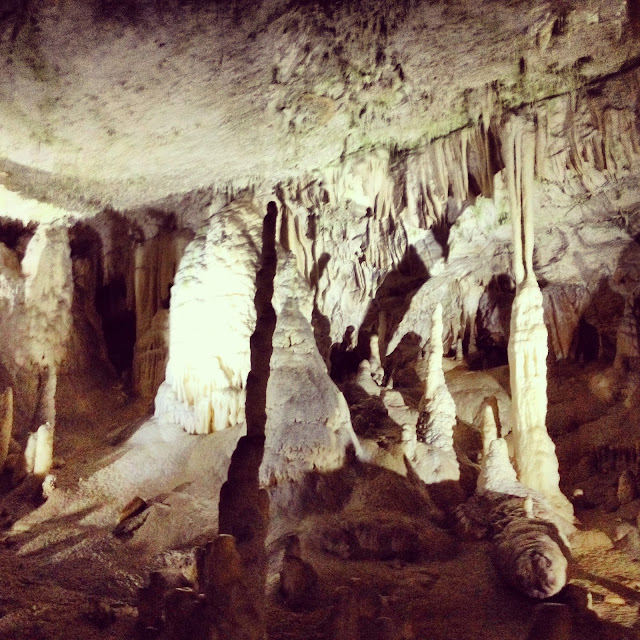Earlier this month Kevin and I went on a little day trip to check-out Predjama Castle! Predjama Castle is a beautiful Renaissance castle built within a cave mouth in south-central Slovenia, in the historical region of Inner Carniola.
On the ride to the castle. It is only about 45 minutes from Ljubljana!
Baby Banana! We packed a lunch for the day. Keeps Kevin happy because he needs to eat every couple hours or he gets "hangry"! :)
Very beautiful and picturesque! The castle in the side of the mountain open to the mouth of a cave! The castle was first mentioned in the year 1274 with the German name Luegg, when the Patriarch of Aquileia built the castle in Gothic style. The castle was built under a natural rocky arch high in the stone wall to make access to it difficult.
Moi and the castle! It was a rainy day but we had a nice time! The castle became known as the seat of Knight Erazem Lueger, owner of the castle in 15th century and a renowned robber baron. He was the son of the Imperial Governor of Trieste, Nikolaj Lueger.
Kevin and the castle! According to legend, Erazem came into conflict with the Habsburg establishment, when he killed the commander of the Imperial army Marshall Pappencheim, who had offended the honour of Erazem's deceased friend, Andrej Baumkircher of Vipava. Fleeing from the revenge of the Holy Roman Emperor Frederick III, Erazem settled in the family fortress of Predjama. He allied himself with the Hungarian king Matthias Corvinus and began to attack Habsburg estates and towns in Carniola.

A headstrong and rebellious knight, Erazem rebelled against the Austrian emperor Fredrick III and eventually killed his kinsman. Thus enraged, the Austrian leader commissioned the governor of Trieste to capture and kill Erazem. This is where the impregnability of Predjama Castle was truly put to the test. For a year and a day, Erazem was besieged in his fortress. But, much to the dismay of his adversaries, he continued to survive and taunt the attacking soldiers by pelting them with cherries. They couldn't figure out how he was getting his supplies. As far as they knew, there was only one way in and out of the valley, and the castle. But the cunning knight knew better. Unbeknownst to the soldiers, Erazem knew of a secret tunnel leading from the castle, which allowed him to travel to the nearby village of Vipava and collect supplies, including hoards of fresh cherries when the season was ripe.

Today you can take tours down the tunnels and caves Erazem used! But it seemed that the soldiers were to have the last laugh. With the strategic placement of a small signal flag, a servant of Erazem was bribed to reveal when his master was in attendance at that place where the elusive knight and even the noblest of men needed to go after consuming lots of cherries and wine: the outhouse. Unfortunately for Erazem, the toilet, situated on the top floor and at the very edge of the castle, was the one place that wasn't so impregnable. When the moment came, the flag was placed there by the treacherous servant. A single cannon ball was launched, and the errant knight was literally caught with his pants down.
The annual medieval tournament, held in July, is named after the notorious 15th-century robber baron Erazem of Predjama. For the duration of the tournament, Predjama returns to the Middle Ages and the castle grounds fill with costumed characters and colourful tournament events.
Mattress made of hay! A view of the renovated castle rooms and their furnishing gives visitors an idea of how people once lived and worked in the castle and how well the castle has been preserved.
He runs it!
The dungeon! This castle I believe held a lot of prisoners including Erazem himself!
Lets get lost.. It was a lot of fun exploring this castle, the inside layout was like a maze, with stair cases and different rooms hidden everywhere.
Canyon fire!
This path was blocked off but wonder were it leads to.. curious of the unknown.
Foggy rainy days make for eery pictures!
This s the highest point we could get up inside the cave but you could see the stairway continued on forever, but was just blocked off for tourist! A secret natural shaft leads out of the castle, which Erazem ordered to be enlarged, and leads into Postojna Cave (11 Km away). This shaft allowed Erazem to secretly supply the castle with food in the time of the siege; he also used it to continue with his robberies.
View outside the hole!
Predjama Castle was used as the castle featured in the 1986 movie Armour of God by Golden Harvest starring Jackie Chan, Alan Tam, Rosamund Kwan and Lola Forner. It was also investigated for paranormal activity in a 2008 episode of Ghost Hunters International on the Sci Fi Channel.
Slovenian Word of the Day:
češnja meaning cherry
PEACE & LOVE,
Kevin & Amanda























































































